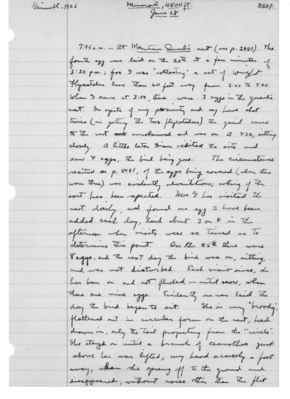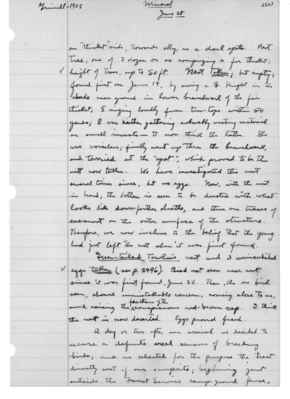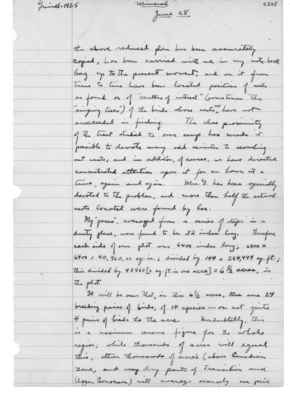Pages That Mention 1925-06-28
1925: Joseph Grinnell's field notes
S2 Page 47
Collector: Grinnell - 1925 Location: Mineral, 4800 ft. Date: June 28 Page Number: 2501
7:45 a.m. - At Mountain Quail's nest (see p. 2481). The fourth egg was laid on the 20th at a few minutes of 2:30 p.m.; for I was "collecting" a set of Wright Flycatchers less than 60 feet away from 3:00 to 3:40. When I came at 3:00, there were 3 eggs in the quail's nest. In spite of my proximity and and my have [sic] shot twice (in getting the two flycatchers) the quail came to the nest and unobserved and was on at 3:30, sitting closely. A little later Dixon visited the site and saw 4 eggs, the bird being gone. The circumstance recited on p. 2481, of the eggs being covered (when there were three) was evidently adventitious; nothing of the sort has been repeated. Mrs. G has visited the nest daily, and found one egg to have been added each day, laid about 3 or 4 in the afternoon when visits were so timed as to determine this point. On the 25th there were 8 eggs, and the next day the bird was on, sitting, and was not disturbed. Each visit since, she has been on and not flushed - until now, when there are nine eggs. Evidently one was laid the day the bird began to sit. She is very "broody", flattened out in circular form on the nest, head drawn in, only the tail projecting from the "circle". She stayed on until a branch of ceanothus just above her was lifted, my hand scarcely a foot away, when she sprang off to the ground and disappeared, with noise other than the flit
S2 Page 48
Collector: Grinnell - 1925 Location: Mineral Date: June 28 Page Number: 2502
her wings. As the [sic] left, in a hurry, the positions of some of the eggs changed; one egg was thrown up the side of the nest a bit. Set taken, 1/9 [See p. 2507]. As previously stated (p. 2481) the nest is on a log, this being old and rotten, flattish on top, even lengthwise hollow or depressed at the point where the nest is. In this longitudinal groove (as it were) is an accumulation of bits of rotten wood, old cone scales, and brown dry last-year's ceanothus leaves. The "nest" is a saucer-shaped depression in this mixture of debris, about 150 mm. across (measured) by 35 mm. deep. About a dozen feathers of the quail enter into the "lining." The whole site is well concealed and protected by the flattened, thorny branches and dead twiggery of the snow-brush which sprawls over the log from the south side. A heavy clump of young firs grows 25 feet to the south and west and serves to shade the place most of the afternoon
Ruby-crowned Kinglet's nest: rim 5180 mm. above ground; in young white fir, 10 inches in diameter 3 ft. from ground; nesting, with practically no attachment on flat mass of fir bough - stem, ^live twigs and needles beneath. Bough, from bole of tree, slightly drooping, towards southwest - sunny exposure. Nest out on bough 960 mm. from bole, in from extreme end of bough 880 mm. Could be seen from ground only
S2 Page 49
Collector: Grinnell - 1925 Location: Mineral Date: June 28 Page Number: 2503
on "thicket" side, towards sky, as a dark spot. Nest tree, one of 2 dozen or so comprising a fir thicket; height of trees, up to 50 ft. Nest taken; but empty; found first on June 14, by seeing a [female symbol] Kinglet inthe shade near ground in lower branchwork of the fir thicket; [male symbol] singing loudly from tree-tops within 50 yards; [female symbol] was either gathering cobwebby nesting material or small insects - I now think the latter. She was voiceless; finally went up thru the branchwork, and tarried at the "spot", which proved to be the nest now taken. We have investigated this nest several times since, but no eggs. Now, with the nest in hand, the bottom is seen to be dusted with what looks like down-feather sheaths, and there are traces of excrement on the outer surface of the structure. Therefore, we now incline to the belief that the young had just left the nest when it was first found.
Green-tailed Towhee's nest and 3 unincubated eggs taken (see p. 2496). Bird not seen near nest since it was first found, June 25. Then, the one bird seen, showed unmistakable concern, coming close to me, and raising the ^feathers of the conspicuous red-brown cap. I think the nest is now deserted. Eggs proved fresh.
A day or two after our arrival we decided to secure a definite areal census of breeding birds; and we selected for the purpose the tract directly west of our campsite; beginning just outside the Forest Service camp-ground fence,
S2 Page 51
Collector: Grinnell - 1925 Location: Mineral Date: June 28 Page Number: 2505
the above reduced plan has been accurately copied, has been carried with me in my note-book bag up to the present moment, and on it from time to time have been located positions of nest as found or of "centers of interest" (sometimes the "singing trees") of the birds whose nests we have not succeeded in finding. The close proximity of the tract studied to our camp has made it possible to devote many odd minutes to searching out nests; and in addition, of course, we have directed concentrated attention upon it for an hour at a time, again and again. Mrs. G. has been specially devoted to the problem, and more than half the actual nests located were found by her.
My "paces", averaged from a series of steps in a dusty place, were found to be 32 inches long. Therefore each side of our plot was 6400 inches long; 6400 x 6400 = 40,960,00 [sic] sq. in; divided by 144 = 284,444 sq. ft.; this divided by 43560 [= sq. ft. in one acre] = 6 1/2 acres, in the plot.
It will be seen that, in this 6 1/2 acres, there were 24 breeding pairs of birds, of 14 species - or not quite 4 pairs of birds to the acre. Undoubtedly, this is a maximum census figure for the whole region; while thousands of acres will equal this, other thousands of acres (above canadian zone, and very dry parts of Transition and Upper Sonoran) will average scarcely one pair
S2 Page 52
Collector: Grinnell - 1925 Location: Mineral Date: June 28 Page Number: 2506
per acre. The tract in question is gently sloping toward the south; while there is no water on it, water is within easy reach, at the camp ground spring 100 yards to the east or at the first willow bog 200 yards to the south. The vegetation is mixed conifer and chaparral, the later by area predominating and consisting almost solely of ceanothus cordulatus, so greatly like by many birds because it affords safe nesting places plus (right now) an abundance of insect life. The conifers on it are chiefly firs (white), but there are also lone yellow pines, affording lofty perches, and some incense cedars.
We have seen many other birds on our plot, besides those named on the map - foragers or vagrants from adjacent ground; for example, Calif. Purple Finches, Siskins, and Evening Grosbeaks; and at night, Pacific Nighthawks. One puzzling case is that of Calliope Hummers, of which 4 males have separate distinct "stands" on our plot. The females come onto the plot to forage about the castillejas plentiful in the brush, but as far as we can judge, these females are only visitors, having there [sic] nests off somewhere, probably in the belt of lodge pole pines down along the willow-bogs, where the males do not go. One male has his "stand" one telefone [sic] wire, which crosses our plot near its southern boundary. Beneath




